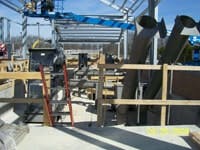Gerald Seidl is senior vice president of Headworks Inc. Seidl can be reached at [email protected] or 713.647.6667.
March 2012 will mark the two-year anniversary for the borough of Mifflinburg’s successful startup of Pennsylvania’s largest membrane bioreactor (MBR). Requirements to improve water quality forced the borough to upgrade its facility to meet regulatory limits for total nitrogen and total phosphorus.
Recognizing the need for change, Mifflinburg management asked engineering firm Herbert, Rowland & Grubic to prepare a capital improvement plan and evaluate the best course of action to meet future wastewater treatment needs. Now, with the capacity to treat 4.4 million gal per day, the Mifflinburg wastewater treatment plant is one of the largest MBRs in operation in the Chesapeake Bay region.
Frontline Protection
To ensure successful operation of the MBR system, new screening equipment was required to safeguard the plant’s investment. Effective screening has been a key concern for MBR owners, operators and engineers. While many municipalities favor single-stage screening over dual-stage screening due to its lower upfront costs, small footprint and lower perceived maintenance cost, the use of single-stage systems can lead to increased downstream maintenance, especially with MBRs.
Membrane fouling is the most serious problem affecting system performance. It is a direct result of suspended solids in wastewater that can damage membranes, decreasing their efficiency and increasing life-cycle costs. Consequences of fouling include increased power consumption, backwashing, cleaning and replacement. The mechanical screens installed at any MBR facility provide critical frontline protection to maximize membrane systems’ efficiency and integrity.
Screens generally are classified into two major types, coarse and fine screens, based on the size of particles that they filter out of influent. Coarse screens have openings larger than 6 mm and typically filter out floatables and other large solid materials. Most modern coarse screens are made by welding steel bars together. They are robust and can remove items as large as car tires. Fine screens, on the other hand, are intended to filter small objects and usually are constructed from wedgewire, wire mesh or perforated plates.
Headworks Inc. designed and installed a dual-stage screening system that included one Mahr bar screen with 6-mm openings to achieve coarse screening, and two Eliminator band screens with 2-mm openings to provide the fine screening necessary to ensure successful membrane operation. The system prevents the buildup of materials on the fine screens, as larger solids are removed in the first step.
Based on the company’s experience with membrane screening systems, it has learned that the fine screens required for adequate protection of MBRs usually need the protection of a more robust coarse screen. Fine screens remove fine solids, but they cannot be expected to be the workhorse like a Mahr bar screen, handling trees, bricks, tires, etc. The 6-mm bar spacing takes out debris that would damage the fine screens, allowing them to do their jobs properly.
Ultimately, there are two lines of defense at the head of the plant to protect the membrane. All of the solids produced by the three screens then are compacted by two Screwpactors for disposal.
Installation Feedback
Steve Benner, project manager for Mifflinburg, described the application’s positive results.
“Although there are viable alternatives in this market, Headworks was able to competitively offer the required equipment, meeting the stringent specifications of the bidding documents,” he said. “They have a track record of successful installations and were a natural choice to provide all of the equipment for the headworks at the Mifflinburg facility.”
“The screens impact the efficiency of the entire facility,” Benner added. “[They] protect our membranes, and overall their performance has been stellar. They were a great partner for a project of this size and scope.”
Download: Here


